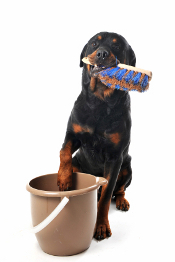Puppy crate training is quite simply the quickest, easiest and most effective way to potty train a puppy, period!
In This Article You Will Read About

Crate training actually works incredibly well when you’re housebreaking an adolescent or adult dog too.
But it’s usually faster to crate train puppies as they haven’t had a chance to really develop ‘bad’ habits, and they pick it up so quickly and easily.
Contrary to what we humans sometimes believe, dogs actually like their crates and a crate becomes their ‘safe’ place…. a quiet, comfy spot away from other pets, dinnertime craziness, noisy vistors and so on.
Why Should I Crate Train My Puppy?
Introducing your puppy to a crate and helping him to accept being crated (don’t leave him in his crate for long periods though!), can also protect both your precious pooch and your home and furnishings.
Puppies don’t understand that chewing on your antique dining room table is somehow not the same as chewing on a sturdy tree branch.
Or that the carpet doesn’t make quite as an acceptable ‘potty spot’ as the grass in the back yard.
Not to mention the fact that puppies have no concept of electrical current, the danger of stairs/balconies/fireplaces etc…. plus they tend to assume everything is being edible until proven otherwise.
Accidents can, and do happen, and as you can’t watch your pup every second of the day, a crate can give everyone some peace of mind.
But, the number one benefit of crate training puppies is how quickly and efficiently it can reduce housebreaking ‘accidents’, and teach bladder/bowel control.
All canines are naturally ‘den’ animals, and the main reason puppy crate training works so well is that it takes advantage of a dogs’ natural desire not to pee/poop where he/she sleeps.
Of course no housetraining method is foolproof… BUT you can help ensure that your puppy crate training experience is a positive one following the few simple steps below….
Puppy Crate Training – How To Choose A Crate
This is where a lot of new owners go wrong…. and it’s usually because they love their new puppy sooo much and want to give him the best of everything!
Of course you SHOULD adore your new puppy, and spoiling him with new toys and possessions is part of the fun, but when it comes to crates bigger is NOT better at this stage.
As I explained earlier, puppy crate training works because it uses the natural canine desire to sleep in a clean ‘bed’. However, a puppy doesn’t need a lot of space to sleep – a king size mattress holds no real appeal (unless you’re on it of course!).
If you buy a crate that is too big, your little Rottweiler puppy will have no difficulty designating a small area for sleeping in and thinking of the rest of the space as his own personal en-suite bathroom.
The same principle applies when you have an older pup or adult and are dog crate training.
This means that you need to pick a crate that is big enough for your little guy to sleep in, but not big enough for him to feel that it’s okay to eliminate in.
QUESTION: How do you know when a crate is the right size?
ANSWER: Choose a dog crate that is big enough for your puppy to stand up, sit down, lie down and turn around in – without touching the sides. That’s it. Any smaller and he’s going to be too cramped, any bigger and he’s going to think he has room for a toilet.
When you’re considering puppy crate training, do bear in mind though that your puppy is going to grow! Rottweiler puppies grow quickly, and you will need to keep an eye on him to make sure that he doesn’t outgrow his crate without you noticing.
You may well need to buy 3 (or possibly more) crates before he’s mature, but successful housebreaking is a huge benefit and in my opinion outweighs the expense!
When you’re crate training puppies, the next thing to consider is which type of crate to choose…. and today there are far more options to consider than there used to be.
QUESTION: Which type of crate is best?
ANSWER: There’s not a one-size-fits-all answer to this as the different types of dog crates all have different ‘pros & cons’, and your home, lifestyle, budget and personal taste all factor in.
A sturdy plastic crate is best if you’re planning on doing much car or air travel. Some dogs prefer the safe, enclosed feeling of this type of crate too.
There are a variety of sizes and levels of durability depending on the manufacturer, they’re generally easy to take apart for cleaning purposes, and come in a big range of colors and styles.
A wire crate isn’t as safe in the car, and isn’t suitable for air travel, but it allows your pup to see what’s going on around him and feel less ‘shut out’.
If you find that the stimulation is too much for him and he does better in a more enclosed area, you can always throw a blanket over the crate.
There are now different color options available in this type of crate, and some have ‘divider’ panels to allow you to use the same crate as your pup grows and so on.
These are the two basic, and very popular, choices but are tons of other options too. There are soft-sided, portable crates, wicker crates, ‘pop-up’ crates and beautiful dog crates that look like an item of living room furniture.
One thing I would suggest though is not buying a really expensive or ‘fancy’ dog crate during the first few months of puppy crate training. Your puppy may have the occasional accident and is quite likely to practice cutting his teeth on it – not to mention outgrow it!
I’d recommend choosing a basic crate design to begin with and then indulge yourself (and him) by buying whatever you like once he’s reliable about clean in it and has passed the teething stage.
Getting Started…….,
Puppies are creatures of habit, and they learn through repetition, so it’s really important to start off the right way.
Have the crate of your choice ready before you bring him home and introduce him to it during his first ‘recon’ of his new home.
Here are a few puppy crate training tips to get you off on the right foot (or paw!)…..
-
- Don’t force your pup into his crate at first. Give him a chance to get used to it a little by throwing a few treats and a favorite chew toy in there and leaving the door open.
-
- For the first day or two you can feed him inside his crate (with the door open) so that he associates something he loves (food!!) with his crate.
-
- Give him one or two safe, sturdy chew toys to keep him occupied and relieve any pent-up anxiety.
-
- Always make sure that your puppy has been outside to ‘do his business’ before you put him in his crate. Otherwise you’re setting him up to fail.
-
- Crate him for short periods only. An 8 week old pup needs a potty break approx. every 30 mins to 1 hour
-
- Give him plenty of ‘crate-free’ time, but supervise VERY CLOSELY to prevent ‘accidents’
-
- Ignore any initial complaints. Never take your puppy out of his crate because he’s fussing, wait for a break in the din before opening the door.
-
- Young puppies need one, often two, potty breaks during the night too.
-
- Don’t leave food/water in his crate when he’s small as that will just make him need to ‘go’.
-
- Remove his collar before putting him in his crate to make sure he can’t hurt himself.
- Don’t leave his crate in the sun, or next to a source of heat. You don’t want him to over-heat.
Due to their limited bladder/bowel control, puppies can’t ‘hold it’ for long even if they really want to!
If you keep your puppy in a crate for too long he will be forced to eliminate and this can undo all the good work you’ve been doing. Remember, puppies learn through repetition and form habits very quickly; if he only pees in there two or three times in a row it can become a habit much more quickly than you would like.
Here’s a guide to how long your pup can stay in his crate…..
-
- 9 – 10 weeks old – 30 mins
-
- 11 – 14 weeks old – 1 – 3 hours
-
- 15 – 18 weeks old – 3 – 4 hours
- 18 weeks plus – 4 – 6 hours
Final Words!
Puppy crate training is very effective, but it’s not a miracle, and most pups will have an ‘accident’ or two during the early days.

If your pup does mess in his crate, chances are….
-
- You forgot to give him a potty break before you put him in his crate.
-
- You left him crated for too long.
-
- He’s too young (under 8 weeks) or has immature bladder/bowel control.
- He has parasites, is sick, or has an upset tummy or a urinary tract infection.
- Is experiencing severe stress/anxiety (such as is seen with dogs who suffer from separation anxiety).
When faced with a mess, remove your pup as quickly as possible and clean the entire crate thoroughly using an enzymatic cleaner or one designed specifically to remove pet odors.
Dogs have very sensitive noses and any lingering traces their own scent can trigger a recurring problem.
Housebreaking is one of the most biggest challenges you’ll face as a new puppy owner, but by following the guidelines above and crate training your Rottweiler puppy you can minimize the stress on everyone!
However, you will need to be very patient, consistent and loving….. and don’t expect your little guy to ‘get it’ within a week, or even a month.
Some pups do of course, but in general when you’re crate training puppies it can take up to 6 months or more of consistent, correct training, before a puppy is fairly reliable in his potty habits.
For more info. and tips on puppy potty training in general, please visit my Housetraining A Puppy page.
When it comes to cleaning up dog pee/poop, there are a LOT of cleaning products and advice available. Some of it is great, other stuff, not so much.
I’ve owned and raised dogs my whole life and I’ve cleaned up many (MANY!) messes over that time. Find out which products I recommend (because they’ve been tried and tested) HERE
Also, get tips and advice on the best way to use them HERE


